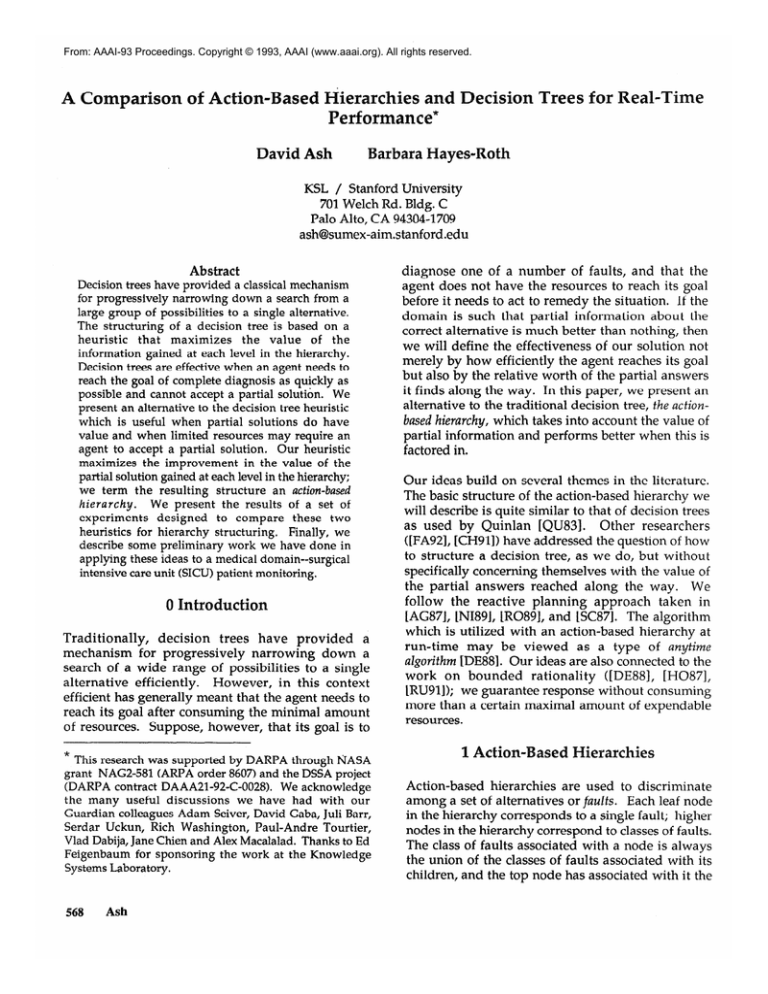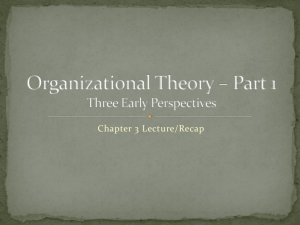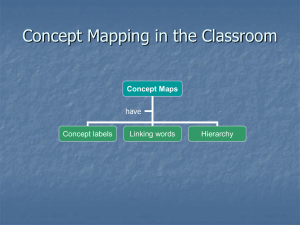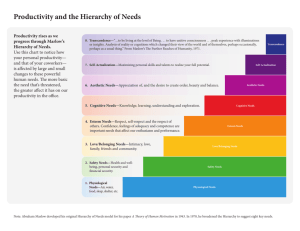
From: AAAI-93 Proceedings. Copyright © 1993, AAAI (www.aaai.org). All rights reserved.
A Comparison of Action-Based
Hierarchies an
Performance*
ecision Trees for Real-Time
David Ash
KSL / Stanford University
701 Welch Rd. Bldg. C
Palo Alto, CA 94304-1709
ash@sumex-aim.stanford.edu
Abstract
Decision trees have provided a classical mechanism
for progressively narrowing down a search from a
large group of possibilities to a single alternative.
The structuring of a decision tree is based on a
heuristic
that maximizes
the value
of the
information gained at each level in the hierarchy.
Decision trees are effective when an agent needs to
reach the goal of complete diagnosis as quickly as
possible and cannot accept a partial solution. We
present an alternative to the decision tree heuristic
which is useful when partial solutions do have
value and when limited resources may require an
agent to accept a partial solution.
Our heuristic
maximizes the improvement
in the value of the
partial solution gained at each level in the hierarchy;
we term the resulting
structure
an action-based
hierarchy.
We present the results of a set of
experiments
designed
to compare
these two
heuristics for hierarchy structuring.
Finally, we
describe some preliminary work we have done in
applying these ideas to a medical domain--surgical
intensive care unit (SICU) patient monitoring.
0 Introduction
Traditionally,
decision
trees have provided
a
mechanism
for progressively
narrowing
down a
search of a wide range of possibilities
to a single
alternative
efficiently.
However, in this context
efficient has generally meant that the agent needs to
reach its goal after consuming the minimal amount
of resources.
Suppose, however, that its goal is to
* This research was supported by DARDA through NASA
grant NAG2-581 (ARPA order 8607) and the DSSA project
(DARPA contract DAAA21-92-C-0028).
We acknowledge
the many useful discussions
we have had with our
Guardian colleagues Adam Seiver, David Gaba, Juli Barr,
Serdar Uckun, Rich Washington,
Paul-Andre Tourtier,
Vlad Dabija, Jane Chien and Alex Macalalad. Thanks to Ed
Feigenbaum for sponsoring the work at the Knowledge
Systems Laboratory.
568
Ash
diagnose one of a number of faults, and that the
agent does not have the resources to reach its goal
before it needs to act to remedy the situation. If the
domain is such that partial information
about the
correct alternative is much better than nothing, then
we will define the effectiveness
of our solution not
merely by how efficiently the agent reaches its goal
but also by the relative worth of the partial answers
it finds along the way. In this paper, we present an
alternative to the traditional decision tree, the actionbased hierarchy, which takes into account the value of
partial information and performs better when this is
factored in.
Our ideas build on several themes in the literature.
The basic structure of the action-based hierarchy we
will describe is quite similar to that of decision trees
as used by Quinlan [QU833.
Other researchers
([FA92], [CH91]) have addressed the question of how
to structure a decision tree, as we do, but without
specifically concerning themselves with the value of
the partial answers reached along the way.
We
follow the reactive planning
approach
taken in
[AG87], [NI89], [R089], and [SCS7]. The algorithm
which is utilized with an action-based
hierarchy at
run-time
may be viewed as a type of anytime
algorithm [DE88]. Our ideas are also connected to the
work on bounded
rationality
([DE88],
[H087],
[RU91]); we guarantee response without consuming
more than a certain maximal amount of expendable
resources.
1 Action-Based
Action-based
hierarchies
are used to discriminate
among a set of alternatives or faults. Each leaf node
in the hierarchy corresponds to a single fault; higher
nodes in the hierarchy correspond to classes of faults.
The class of faults associated with a node is always
the union of the classes of faults associated with its
children, and the top node has associated with it the
set of all faults. In order to help the agent achieve its
goal, there are tests available that it can perform.
Each outcome of a test will identify the correct fault
as being in one of a number of not necessarily
Each test has
disjoint subsets of the set of all faults.
an associated cost which is a heuristic estimate of the
difficulty of performing the test. For instance, in a
real-time domain, the cost of a test might be the time
consumed by the test.
There are also actions which can be performed;
the
agent tries to identify the correct fault because it
needs to find an action to remedy
that fault.
Therefore, for every (action, fault) pair there is a value
representing
a heuristic estimate of the value of
performing a particular action if a particular fault is
present.
This value ranges from -1 (undesirable
action) through 0 (neutral) to +l (ideal solution).
node with one child corresponding
to each possible
outcome of the test. More formally, the following
algorithm could be run to structure a hierarchy for
use by the agent in real time:
Fl
Actions
Al A2 A3 A4 A5
Tests
Faults z
F4
The main idea behind an action-based
hierarchy is
that associated with each node in the hierarchy there
is a corresponding
action which has the highest
expected value given that the agent knows the fault
falls within the set associated with this node, but has
not yet discriminated
among the node’s children.
This action can then be performed if the agent is
required to act (e.g. it reaches a deadline) but has not
yet completed its diagnosis.
The action might be
suboptimal
(depending
upon which fault actually
turns out to be present), but is likely to be much
better than doing nothing.
Figure 1 shows a sample action-based
hierarchy.
There is a set of four faults Fl, F2, F3, and F4, and the
top of the diagram shows a hierarchy with a test
used to distinguish among the children of each node.
The faults associated with each node, as well as the
action with the best expected value, are shown in the
boxes at each level in the hierarchy. The box at lower
right shows how performing each test enables us to
distinguish among faults; the box at lower left gives
values for each (action, fault) pair.
2 Hierarchy Structuring
Given a set of faults, and the associated tests, costs of
tests, actions, and values of actions, there are many
hierarchies that could be constructed, although not
all such hierarchies would be equally useful. Indeed,
a hierarchy could be constructed by starting with the
root node, and recursively selecting tests which.help
discriminate
among the faults associated with the
current node, and adding children to the current
Figure 1: Sample Action-Based
Hierarchy
Start at the top of the yet-to-be-built
hierarchy,
sociating the set of all faults with this top node.
Pick a leaf node in the hierarchy in DFS order, or
stop if there are no more leaf nodes to expand.
Associate with this leaf node the action which has the
highest expected value for the set of faults associated
with this node.
If the leaf node cannot be expanded further, go
ck to step 2 and pick another leaf node.
Find all tests relevant
to the set of faults
associated with the current node.
If no tests were found in step 4, go back to step 2
d pick another leaf node.
0
Determine
which test found in step 4 is best
according to some heuristic.
Expand
the current
node with one child
corresponding
to each possible outcome of the test
found in step 6, and the associated fault sets suitably
adjusted.
0
Go back to step 2 and pick one of the children of
the current node.
Note that this algorithm will never get stuck in a
local maximum at any node as long as there are
relevant tests for expanding a node. Once we have
constructed
a hierarchy in this manner, it is very
simple to use it--the agent simply performs
the
following algorithm in real time:
Real-Time Planning & Simulation
569
Label the root node of the hierarchy
as the
current best hypothesis.
Perform the test associated with the current best
0
If an action is required before this test
hypothesis.
can be completed, perform the action associated with
e current best hypothesis.
When the test results come back, refine the
current best hypothesis
to the one of its children
pointed to by the result of the test.
2.1
Different
Structuring
Heuristics
for
Hierarchy
The variable we are most interested in in the current
paper is the particular heuristic used in step 6 of the
hierarchy
structuring
algorithm.
The traditional
decision tree approach is to take the prior probability
P(f) of each fault f, the set of faults F associated with
the current node (a subset of all the faults), and the
set of outcomes T of the test (each outcome is a
subset of F), and then to compute the following
function:
C IYtMt)
&T
where
The effective result of this approach is that the agent
maximizes the expected information content of the
result of the test. This guarantees that the agent will
reach its goal of diagnosing
a single fault in the
minimum
possible
time, but does nothing
to
guarantee that it will find actions of high value along
the way. We take a different approach. In addition
to the functions
defined
above, we use a cost
function C(t), and a value function V(f,a) giving the
value of action a for fault f. The function we wish to
maximize is:
VCWWF~
C(T)
where
V(Fo) = ma%,.g
and Fg is a any set of faults.
570
Ash
2.2 Evaluating
Hierarchy Performance
In order to effectively
compare the performance
gained through the use of different hierarchies, we
need to have
a method
of evaluating
that
performance.
We assume that the cost of a test (the
resources consumed by the test) is equal to the real
time consumed by the test, but our ideas apply just
as well to other types of cost which can be measured
by a real number. Because of the assumed real time
flavor, we will refer to the maximum time the agent
is allowed to consume before acting as the deadline.
On any given occasion where the hierarchy is used
and a fault is present, the agent will start at the top of
the hierarchy and refine the current best hypothesis
until it reaches a leaf node or its deadline.
At any
given point in time, therefore, there will be a current
best hypothesis, an associated action, and a value of
that action for the fault. It is this value which forms
the basis for our evaluation.
The value of the action
associated with the current best hypothesis becomes
a step function of time representing the performance
of the hierarchy in one particular instance.
Action A5
1.0
0.8
Action A3
Value of
0.6
Best Available
0.4
Action
v(a,FoJ
0
ST
c PM
kT
(Note that an assumption is being made here that if
one fault appears in more than one of the outcomes
of a test, then if the fault is present, each of those
outcomes is equally likely. This assumption will be
made throughout the paper.) The intuition above is
that the agent performs the test which will yield the
highest expected increase in the value of the best
action available to date.
0.0
Also
c VWPW
V(T) =
W(aSo)
VCa,Fg) = P&o)
and
Figure 2: Hierarchy
1
2
3
Time Consumed
Performance
4
on Fault F4
For example, Figure 2 shows the performance of the
hierarchy illustrated
in Figure 1 on the fault F4,
assuming that all tests have constant time (or cost) of
1.
We can now define the average
hierarchy
performance as follows:
ECf,t) =
P(qF)Hf,pf,t)
Pf
where the summation
is over all paths Pf from the
root node to a leaf node corresponding to fault f, and
ECf,pf,t’ denotes the performance
of the hierarchy
over time assuming
leaf node.
The proof is based on the fact that the action-based
hierarchy
structuring
algorithm
is a greedy
algorithm, and when test values are additive the
agent does best by simply performing the apparently
best test first without considering lookahead.
that the path pf is taken to the
4 Formal Experiments
The function P(F?I) denotes the probability
that path pfis taken given that fault f is present.
Having defined the performance of the hierarchy for
a particul ar fault, we can define
the overall
performance
of the hierarchy
as the weighted
average of the performances for each fault:
EW gives the performance
possible deadlines f.
of the hierarchy
The values of tests are additive. The value of a
st is given by the function V(T) defined in section 2.
Two tests T1 and ‘I’2 may be combined into a single
test T by combining
their results:
Additivity
means
The assumptions outlined in the last section clearly
do not hold in general.
Therefore,
we designed
experiments to test the following two hypotheses:
Using the action-based
hierarchy will provide
substantially
better performance
than the decision
tree when evaluated as described in section 2.
Using the decision tree will provide substantially
better performance when only speed in reaching a
leaf node matters.
at various
It is possible to prove that under certain well-defined
assumptions,
the performance
of action-based
hierarchies is optimal. Specifically, we need to make
the following assumptions:
A t2 E T2].
The structuring of the hierarchy conforms with
e algorithm given at the start of section 2.
For any set of faults, there is always an action
available which has positive expected value so that
doing something is better than doing nothing.
T = {fj nt2 : f 101
that the value of the
combination
is the sum of the values of each test:
VU) = VCT1) + VCT2). In a similar manner, additivity
must also apply to combinations
of more that two
tests.
The value of any test or combination of tests is
constant for all faults. That is, if this constant is 0.7
for a given combination of tests, then for any set of
faults corresponding
to particular outcomes of these
test, the best action available will have value 0.7 for
1 the faults in the set.
The deadline occurs immediately
following a
successful refinement of the current best hypothesis.
The experimental
method was to randomly assign
prior probabilities,
test outcomes,
and values of
The prior probabilities
were
actions for faults.
assigned by dividing the interval [O,l] into uniformly
Each test was randomly
distributed
partitions.
assigned to divide the fault set into two equal parts
(the number of faults was always even). No fault
appeared as part of both outcomes of a particular
test.
The values of actions for faults were also
randomly distributed in the interval [O,l].
d
0.9
can
Value 0.8
of
Best
0.7
Action
0.6
I
0.5’
4
6
8
Deadline
Figure 3: Hierarchy Performance
Different Deadlines and
10
2
with
Figure 3 shows the difference in performance, over
time, of action-based hierarchies, decision trees, and
the randomly structured hierarchies.
This shows
ail-Time PBanning & Simulation
571
that action-based
hierarchies always do at least as
well as the other approaches,
no matter what the
value of the deadline
(the amount of resources
available
for diagnosis),
but that this advantage
varies over time from nil at time zero, to a maximum
for deadline values of around 3 or 4, back to nil for
This corresponds,
roughly
large deadline values.
speaking, to the fact that all hierarchies
perform
equally well at their root and their leaf nodes, but
that at the intermediate nodes there is an advantage
for certain hierarchies over others.
The reader may wonder why there are not certain
time points at which decision trees would have an
The
advantage
over action-based
hierarchies.
for individual
answer
appears
to be that
performance profiles DT might have an advantage at
certain time points, but this charateristic is lost when
we compute the average.
Now, suppose we are not interested in intermediate
nodes but only in getting to a leaf node as quickly as
possible.
In Figure 4, we show a graph of the
probability that a leaf node has been diagnosed by
particular deadline values. Looking at this figure it
is apparent that over a relatively small range of the
deadline (between about 4 and 7) using a decision
tree offers a very significant advantage over the other
However,
for other values of the
approaches.
deadline, it makes very little difference.
1 Action:
Test:
Transfuse
RBC Conditional
HCT, Chest Tube Outuut,
1 Fault:
1
Uncontrol.
Action:
Consider
1
Radial MAP
Vessel
Surged!
11 Fault:
Low Pk. Count
ActionSimple Pltlts.
I
I
edical Action-Based
Figure 5: Portion of
Hierarchy
1
0.8 I
Mean
1
Value 0.61
of
Best
Oa4 I
Action0 . 2
0 t2
4
6
Deadline
Figure 4: Hierarchy Performance
All-or-Nothing Evaluation
5 Implementation
10
8
using
Ash
Figure 6 shows the results of an experiment
run
using the medical
problem
similar to the ones
described
in section 4.
In this experiment
we
assumed that all tests took constant time to come
back (30 minutes).
As can be seen, for small values
of the deadline, action-based
hierarchies enjoyed a
modest advantage over decision trees. For larger
values of the deadline (not shown here) there was no
discernable difference.
We anticipate that if we took
test times into account, the advantage of ABH over
DT would be much more noticeable, even for larger
values of the deadline.
in a Medical
(ReAct)
We have used the idea of an action-based hierarchy
to structure the knowledge base for a system, called
ReAct, designed to provide fast response time in a
572
surgical
intensive
care unit (SICU).
ReAct is
described
in detail in [AS931 and is part of the
Guardian SICU patient monitoring system [HA921.
Because it uses an action-based hierarchy, ReAct is
able to meet deadlines. This is in contrast with other
medical AI systems ([BR87], [CL891, [FA801, and
[HO8911 which perform diagnosis
efficiently
but
without specifically
addressing
deadline
issues.
Knowledge
regarding
faults, tests, costs of tests,
probabilities of faults, etc., has been provided by a
medical expert; the hierarchy structuring algorithm
has been used to produce an action-based hierarchy.
A small part of the hierarchy is shown in Figure 5. In
applying these ideas to a real-world domain, we are
interested in determining whether the same results
as reported earlier in this paper apply.
In this
domain, the theoretical assumptions made in section
3 will definitely not apply;
nor will the variables
necessarily fit the random distributions used to run
the experiments described in section 4.
In addition to the domain experiments described in
section 5, we intend to explore a number of different
avenues in our ongoing research. The first question
is whether there are other, still better heuristics
which could be used to structure the hierarchy. We
have tried combining
the two heuristics,
and we
expect that a more sophisticated combining function
than we have used could lead to behavior which is
better than either algorithm in certain circumstances.
Another question is whether better performance
could be obtained by altering the basic structure of
the solution. At present, only one test is performed
at each node in the hierarchy.
In the domain
described in section 5, this approach would be the
exception rather than the rule: generally physicians
will order a whole battery of tests to help them
distinguish among the children of the current node.
Thus, our hierarchies
should be able to perform
similarly
if we hope to achieve
performance
comparable to that obtained by physicians.
0.4
Mean 0.3
Value
of
0.2
Best
Action 0.1
DT
0
30
60
Deadline (in minutes)
Figure 6: Hierarchy Performance
Medical Problem
90
in
Our measures for cost and value (numbers between 0
and 1) are quite crude and may not be sufficient in
many domains. Therefore, we intend to explore the
process of hierarchy structuring in domains where
we have more sophisticated
notions of cost and
value.
References
[AG87]
Agre, P., Chapman,
D.
Pengi:
an
implementation
of a theory of activity. Proceedings
of the Sixth International
Conference
on Artificial
Intelligence, 268-272,1987.
[AS931
Ash, D., et.al.
Guaranteeing
real-time
response
with
limited
resources.
Artificial
Intelligence in Medicine, 5( 1):49-66,1993.
[BR87]
Bratko,
I., Mozetic,
I., Lavrac,
N.
Automatic
synthesis
and
compression
of
cardiological
knowledge.
Machine Intelligence 2 I,
pp 435-454,1987.
Sensible
[CH91]
Chrisman,
L., Simmons,
R.
planning:
focusing perceptual attention.
Ninth
National Conference on Artificial Intelligence, 756-761,
1991.
[CL891
Clarke, J., et.al. TraumAID: a decision aid
for managing trauma at various levels of resources.
Proceedings of the Thirteenth Annual Symposium on
Computer Applications in Medical Care, Washington,
DC, November, 1989.
[DE881
Dean, T., Boddy, M. An analysis of timedependent planning. Seventh National Conference on
Artificial Intelligence, 49-54,1988.
[FA80]
Fagan,
L.
VM:
representing
timedependent
relations in a medical setting.
PhD
Thesis, Computer Science Department,
Stanford
University, June, 1980.
[FA92]
Fayyad,
U., Irani, K.
The attribute
selection
problem in decision
tree generation.
Tenth National Conference on Artificial Intelligence,
104-l 10,1992.
[HA921
Hayes-Roth,
B., et.al.
Guardian:
a
prototype
intelligent
agent for intensive-care
monitoring. Artificial Intelligence in Medicine, 4:165185,1992.
[HO871
Horvitz, E. Reasoning about beliefs and
actions under computational resource constraints.
Proceedings
of the 2987 AAAI
Workshop
on
Uncertainty in Artificial Intelligence, 1987.
[HO891
Horvitz, E., et.al. Heuristic abstraction in
the
decision-theoretic
Pathfinder
system.
Proceedings of the Thirteenth Annual Symposium on
Computer Applications in Medical Care, Washington,
DC, November, 1989.
[NI891
Nilsson,
N. J.
Action
Networks.
Proceedings from the Rochester Planning Workshop:
From Formal
Systems
to Practical
Systems,
J.
Tenenberg et al., ed., University of Rochester, 1989.
[QU83]
Quinlan, J.R. Inductive inference as a tool
for the construction
of high-performance
programs.
In R.S. Michalski, T.M. Mitchell, and J.
Carbonell,
Machine
Learning,
Palo Alto, Calif .:
Tioga, 1983.
[R0891
Rosenschein,
S. J.
Synthesizing
information-tracking
automata from environment
descriptions.
Proceedings of Conference on Principles
of Knowledge Representation and Reasoning, Morgan
Kaufmann, San Mateo, CA, 1989.
[RU91]
Russell,
S., Wefald,
E.
Principles
of
metareasoning.
Artificial Intelligence,
49:361-395,
1991.
[SC871
Schoppers, M. Universal plans for reactive
robots in unpredictable
environments.
Tenth
International Joint Conference on Artificial Intelligence,
1987.
Real-Time Planning 2%Simulation
573




